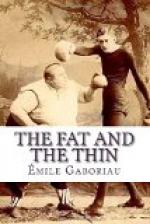It should be mentioned that the article of M. Zola’s young days to which I have referred is not one on market life in particular, but one on violets. It contains, however, a vigorous, if brief, picture of the Halles in the small hours of the morning, and is instinct with that realistic descriptive power of which M. Zola has since given so many proofs. We hear the rumbling and clattering of the market carts, we see the piles of red meat, the baskets of silvery fish, the mountains of vegetables, green and white; in a few paragraphs the whole market world passes in kaleidoscopic fashion before our eyes by the pale, dancing light of the gas lamps and the lanterns. Several years after the paper I speak of was published, when M. Zola began to issue “Le Ventre de Paris,” M. Tournachon, better known as Nadar, the aeronaut and photographer, rushed into print to proclaim that the realistic novelist had simply pilfered his ideas from an account of the Halles which he (Tournachon) had but lately written. M. Zola, as is so often his wont, scorned to reply to this charge of plagiarism; but, had he chosen, he could have promptly settled the matter by producing his own forgotten article.
At the risk of passing for a literary ghoul, I propose to exhume some portion of the paper in question, as, so far as translation can avail, it will show how M. Zola wrote and what he thought in 1867. After the description of the markets to which I have alluded, there comes the following passage:—
I was gazing at the preparations for the great daily orgy of Paris when I espied a throng of people bustling suspiciously in a corner. A few lanterns threw a yellow light upon this crowd. Children, women, and men with outstretched hands were fumbling in dark piles which extended along the footway. I thought that those piles must be remnants of meat sold for a trifling price, and that all those wretched people were rushing upon them to feed. I drew near, and discovered my mistake. The heaps were not heaps of meat, but heaps of violets. All the flowery poesy of the streets of Paris lay there, on that muddy pavement, amidst mountains of food. The gardeners of the suburbs had brought their sweet-scented harvests to the markets and were disposing of them to the hawkers. From the rough fingers of their peasant growers the violets were passing to the dirty hands of those who would cry them in the streets. At winter time it is between four and six o’clock in the morning that the flowers of Paris are thus sold at the Halles. Whilst the city sleeps and its butchers are getting all ready for its daily attack of indigestion, a trade in poetry is plied in dark, dank corners. When the sun rises the bright red meat will be displayed in trim, carefully dressed joints, and the violets, mounted on bits of osier, will gleam softly within their elegant collars of green leaves. But when they arrive, in the dark night, the bullocks, already ripped open, discharge black blood, and the trodden




